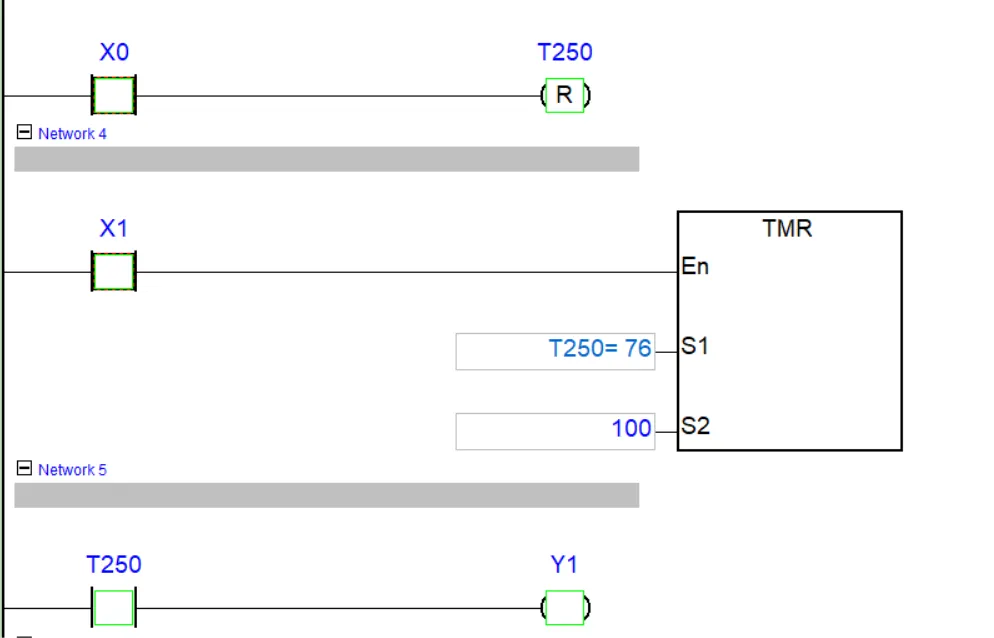Delta PLC Timer Instruction in Ladder Logic – Complete Guide with Examples
Published on May 30, 2025 | Category: timerShare this Page:
A timer in a PLC is an instruction that allows the programmer to count time, typically starting from zero and incrementing the Present Value until it reaches a predefined Preset Value (S2). In Delta PLCs, timers are essential for time-based control operations and are available in both low-speed and high-speed types. In Delta PLCs, timers are essential for time-based control operations and are available in both low-speed and high-speed types. The time base (unit) of Delta PLC timers can be 1 ms (millisecond), 10 ms, 100 ms. for example If you use timer T0 with a Preset Value of 100, and T0 operates with a 100 ms time base, the timer will reach the set value after: 50 × 100 ms = 5000 ms = 5 secondsSo, the timer will count from 0 to 50 in 100 ms steps, totaling 5 seconds, and then activate the timer coil (T0). in this article we Learn how to use the Delta PLC Timer Instruction in Ladder Logic programming. Step-by-step examples and clear explanations for beginners and advanced users.
what is a function of timer in delta plc
The units of the timer are 1ms, 10ms and 100ms and the counting method is counting up. When the present value in the timer equals the set value, the output coil will be On. The set value should be aK value in decimal and the data register D can also be a set value.
actual set time in the timer = timing unit × set value
For example, if a timer is 100 ms, then the timer output will turn ON when 100 ms × Preset Value is reached.
how many types of timer availavle in delta plc ispsoft
Unlike some other PLCs that use special function blocks for each timer type, Delta PLC timers do not require separate instruction functions. Instead, they use dedicated timer addresses, and the behavior of the timer is defined by the address used. These timer addresses may vary depending on the PLC model and timer type. Delta PLC timers are further categorized into:
- General-Purpose Timers (used for basic timing functions)
- Accumulative Timers (retain elapsed time across power cycles or conditions)
- Subroutine Timers (used within specific program sections).
Timer Address Range in Delta PLC
In Delta PLCs, timers are represented by the letter T followed by a number (e.g., T0, T1, etc.). The range, resolution, and type of timers vary depending on the PLC model. Below is a detailed breakdown for each series:
- ES/EX/SS Series MPU: (Total: 128 timers)
- T0 – T63: 100 ms general-purpose timers
- T64 – T126: 10 ms general-purpose timers
Note: M1028 = ON for 10 ms mode; OFF for 100 ms mode - T127: 1 ms general-purpose timer
- SA/SX/SC Series MPU: (Total: 256 timers)
- T0 – T191: 100 ms general-purpose timers
- T192 – T199: 100 ms subroutine timers (non-latched)
- T200 – T239: 10 ms general-purpose timers (non-latched)
- T240 – T245: 10 ms accumulative timers (latched)
- T246 – T249: 1 ms accumulative timers (latched)
- T250 – T255: 100 ms accumulative timers (latched)
- EH2/SV/EH3/SV2 Series MPU: (Total: 256 timers)
- T0 – T191: 100 ms general-purpose timers (latching configurable via parameters)
- T192 – T199: 100 ms subroutine timers
- T200 – T239: 10 ms general-purpose timers (latching configurable via parameters)
- T240 – T245: 10 ms accumulative timers (latched)
- T246 – T249: 1 ms accumulative timers (latched)
- T250 – T255: 100 ms accumulative timers (latched)
What is a General-Purpose Timer in Delta PLC?
ll A general-purpose timer in Delta PLC is used for basic timing operations in automation programs. It starts executing by incrementing its current value by 1 at a fixed interval based on its time base. For example, a 100 ms timer increases its counter every 100 milliseconds. When the current value reaches the preset value S2, the timer stops counting, and its output coil is turned ON or activated.
Below is an example of a 100 ms general-purpose timer in Delta PLC:
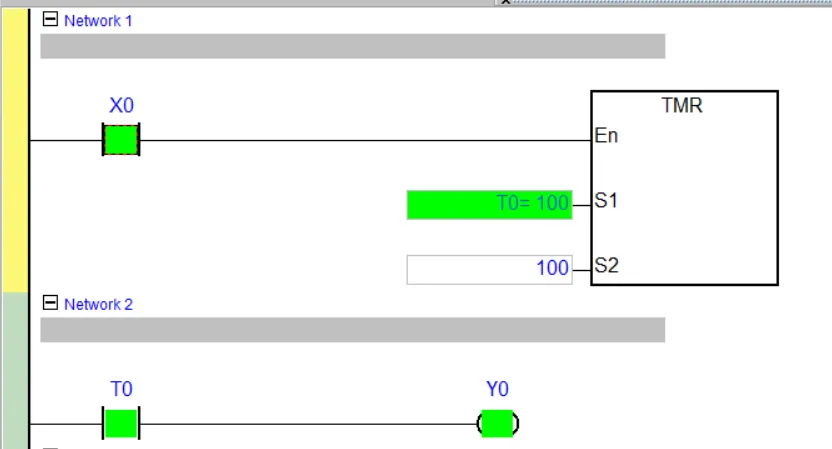
10 ms General-Purpose Timer in Delta PLC
A 10 ms general-purpose timer works similarly but with a finer resolution. It increments the current value every 10 milliseconds, allowing for more precise time control in fast-response applications. This timer is typically available in Delta PLC models like SA, SX, SC, and EH series, and can be configured through specific timer addresses.
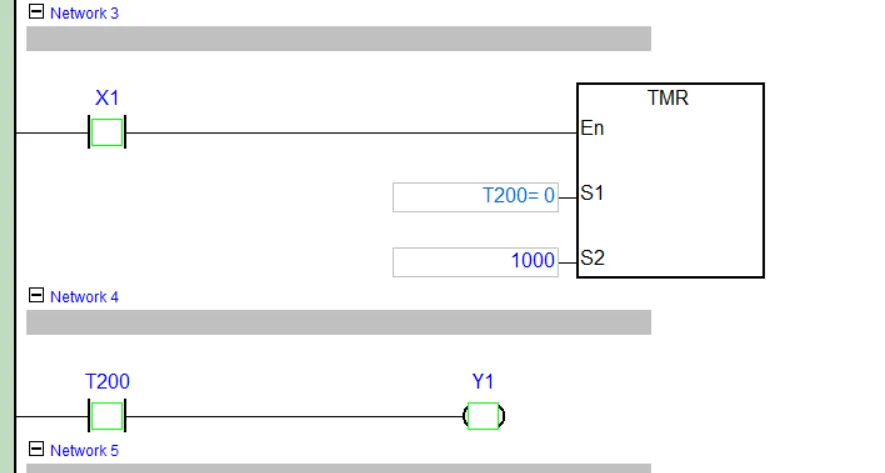
What is an Accumulative Timer in Delta PLC?
An accumulative timer in Delta PLC is a type of timer that retains its current time value even after the timer input is turned OFF. This means the timer "accumulates" time across multiple ON-OFF cycles until the present value reaches the preset value S2. Once the PV equals the SV, the timer coil turns ON.
Accumulative timers are useful in applications where you need to measure total time across intermittent signals. These timers are typically available in 100 ms, 10 ms, and 1 ms time bases, depending on the PLC model and timer address used.
Below is an example of a 100 ms accumulative timer in Delta PLC:
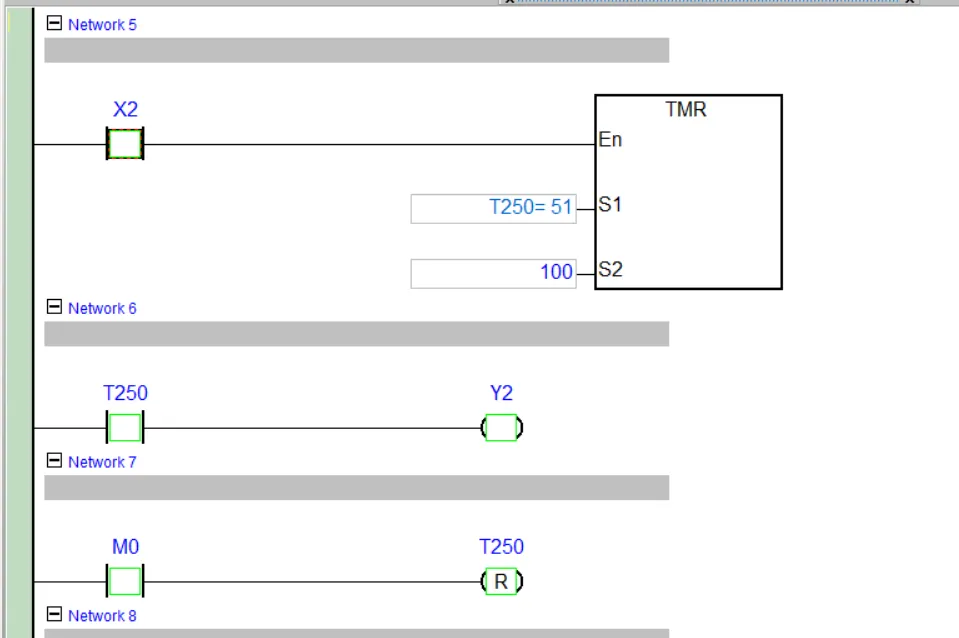
10 ms Accumulative Timer in Delta PLC
The 10 ms accumulative timer increments its PV by 1 every 10 milliseconds while the input is ON, and holds the current value when the input is OFF. It continues counting from the previous PV value when the input turns ON again. These timers are typically available at specific addresses (e.g., T240 – T245 in some Delta PLC models) and are fixed as latched timers.
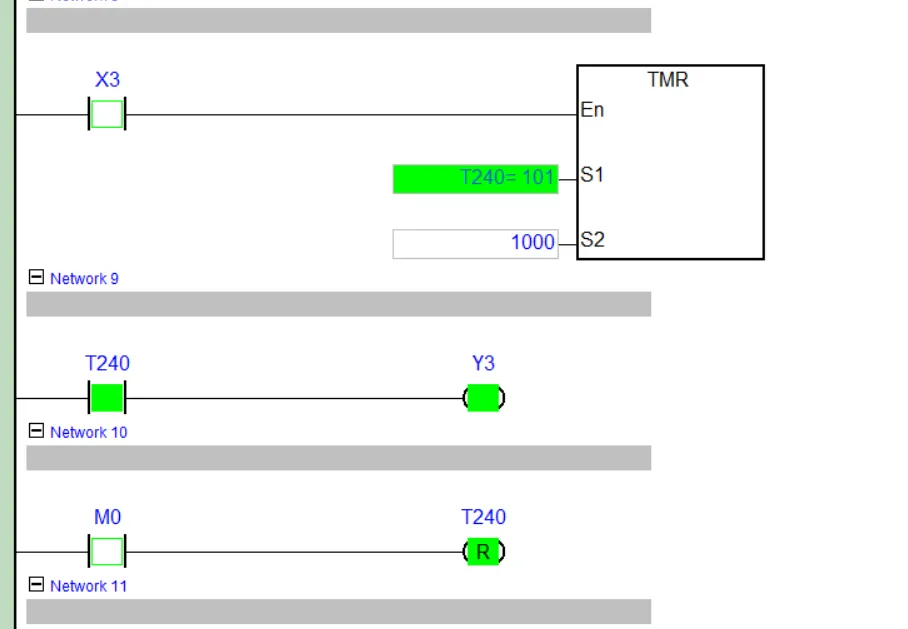
1 ms Accumulative Timer in Delta PLC
The 1 ms accumulative timer offers the highest time resolution, incrementing the PV every 1 millisecond. Like other accumulative timers, it preserves the elapsed time across multiple input cycles. This makes it ideal for high-precision time tracking in fast processes. In Delta PLCs, these timers are usually found at addresses such as T246 – T249.
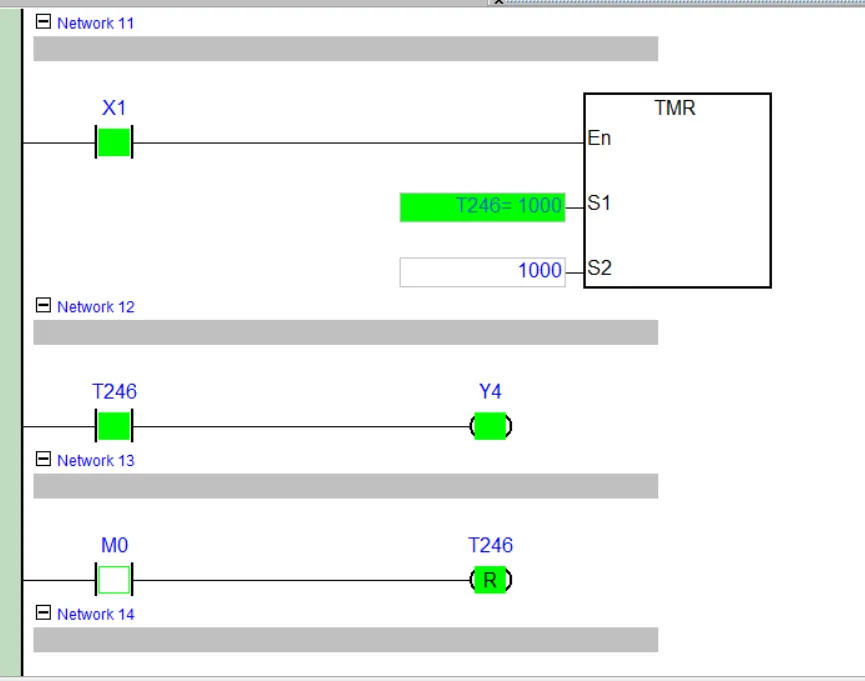
How to Reset an Accumulative Timer in Delta PLC?
To reset an accumulative timer in Delta PLC, use a reset coilpresent value (PV) is cleared and reset to zero.
In the example below, the timer is reset when the reset input is activated:
